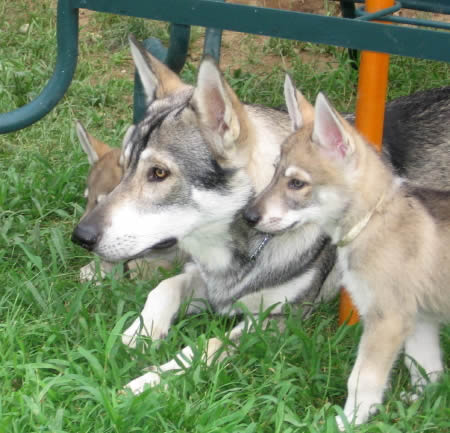The Tamaskan breed started with 5 husky type dogs that were imported to the UK from America in the 80’s. Very little is known about the original breeding programs and origins of the dogs involved, as no records were made available. What we do know is that these 5 original dogs were bred to Alaskan Malamute, Siberian Husky and German Shepherd crosses. The idea in mind was to create a dog that resembled a wolf, with working ability as well as a good temperament. The priority was to create a well-rounded family dog. In the early days, with selective breeding, these dogs were mated to either pure Siberian Huskies or first generation crossbreeds. German Shepherds and Alaskan Malamutes were also used in the original breeding programs. Eventually they were selectively bred to each other for a few years in the effort to create a wolf look a like.
Originally they were given the name “Wolf-Dog”, but since there was no wolf content this name was misleading. In 1988 the name was changed to Northern Inuit (NI) and the Northern Inuit Society was formed shortly thereafter. As the breed evolved so did differences of opinion on how the breed was developing. This led to a split and a new society was started. Since the two societies were moving in different directions one had to disassociate itself from the other. They changed the breed name to Utonagan, and the society became the Utonagan Society. Even though the Utonagan started looking different from the NI, and had exemplary temperaments, they still did not look enough like a wolf. Soon there was another split due to differences of opinion and a new society, The British and International Utonagan Society (BIUS), was created. This new society was headed by the President of the original Utonagan Society along with some of their members. The original Utonagan Society ceased to exist for a period of time until a new committee resurrected it.
The BIUS set rules and regulations, a code of ethics and provided breeders contracts. They also started a hip scoring and eye-testing scheme. They continued to selectively breed and improve the type. The dogs being bred now started to look different from the dogs bred by the original Utonagan Society. Sadly, due to poor recording keeping by the original breeders, dogs that were closely related were mated. This was not discovered till much later and resulted in health issues in the breed. Although the BIUS kept all records of mating’s and health issues, what they needed was an infusion of healthy unrelated bloodlines. They had to find a bloodline that had the look and working ability that was needed without compromising the temperament they already had.
In 2005, the search for other wolfy looking dogs with similar ancestry and appearance led to Lapland where dogs were being bred for sled pulling in extreme temperatures. These dogs were close ancestors to some of the best sled racing dogs in the world and could only enhance the breeds working ability. After some negotiations, a female was imported to the UK in early 2005 and another 6 dogs booked to import from the same kennel in early 2006. With this collection of new bloodlines now organized it was time to look to the future.
At the same time the original Utonagan Society was resurrected with a new committee who did not want to follow the standards set by the BIUS or to include new bloodlines in their breeding programs. After much debate the BIUS decided to close down the society. When considering the infusion of fresh bloodlines, which would create a ‘new’ dog that would not resemble the original Utonagan, this decision was inevitable.
In 2005 the original female imported from Lapland was taken back to Finland along with 7 dogs selected from the Bluestag Kennels of UK. When the time came the six reserved dogs were collected from Lapland. Of the six, two (a male and a female of different litters) were sent to the UK.
Early 2006, after the BIUS was closed down, the committee members formed the Tamaskan Dog Register. Tamaska means ‘Mighty Wolf’ in a North American Indian language. The Tamaskan Register based in Finland is the governing body for all Tamaskan dogs throughout the world, including Tamaskan Dog Society of Great Britan and the National Tamaskan Club of America.
In 2006 Tamaskans were exported from Finland to Holland, UK and Sweden. Both Finland and the UK exported dogs to the USA. Even more were sent overseas to USA, UK and Germany in 2007.
The Tamaskan has the potential for a bright future. Though they
originated from the NI then developed into the Utonagan, the
Tamaskan is a breed apart. The main differences from the present
day Utonagan are the depth of stop, shape of head and length of
coat. The Utonagan also accepts a wide range of colors and markings
where the Tamaskan holds true to the standards of red or gray wolf
coloring.

Learn more about this breed and related
breeds:
Copyright 2012 Double J Kennels
Website created & hosted by
